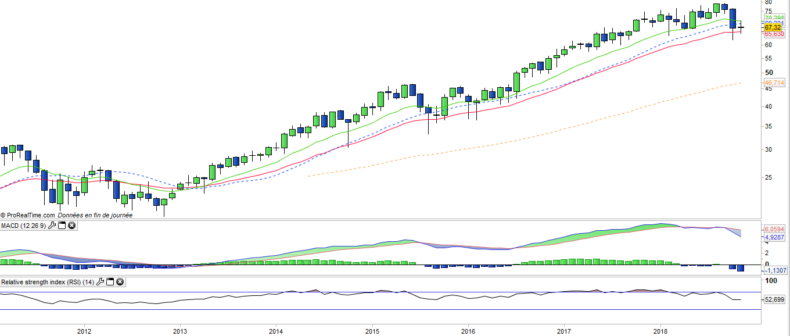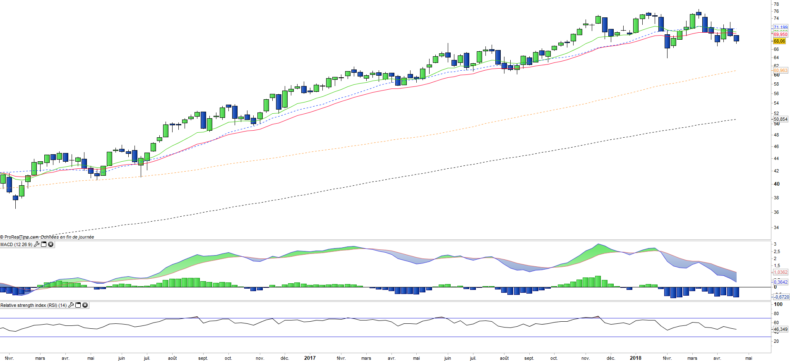SPDR S&P Semiconductor ETF (XSD) - 23/11/2018
Short Term strategy: Negative (30%) / Trend =
Long Term strategy: Neutral (50%) / Trend -
Characteristics of the ETF
The XSD ETF (SPDR) created in 01/2006 is listed in USD on the Nyse and aims to faithfully reflect the US semiconductor industry, through the S & P Semiconductor select industry index. XSD is made up of 35 all-American stocks and is capped in terms of weightings, which limits the weight of giants such as Intel or Texas Instrument to about 4% of the index.
This ETF bears a 0.35% fee with AUM of approximately $242M. The replication method is direct (physical) and the dividend distribution is quarterly.
Alternative ETFs: SOXX (iShares in USD), PSI (Invesco in USD),
Index & components
XSD replicates a diversified index of the US semiconductor industry, with market capitalizations ranging between $ 565m and $ 215bn (Intel) while limiting the maximum weighting at around 4%. This has the consequence of giving a large place to the midcaps while including the American leaders such as Intel, Texas Instrument or Qualcomm. The index is also more volatile in nature, as large caps play less of a buffer role.
The semiconductor industry remains cyclical, as it depends on final demand and therefore on global consumption for a large part (smartphones, PCs, cars, etc.) and also depends on capacity, particularly with regard to memories. But it is mainly a growth sector, because of the increasing weight of electronics in most products and infrastructures while the constant increase of computing power (Moore's law) is a structural factor of renewal of products.
After having exceeded $ 200 billion in 2000 and $ 300 billion in 2010, the global semiconductor market reached the $ 420 billion mark in 2017, an increase of about 22% in global chip consumption. This strong increase is due to the rise of the memory market, which jump by 52%. The supply tensions that are emerging in the memory market are allowing manufacturers of Drams and Flash NAND to increase their prices, thus boosting their revenues and margins. This is what allows Samsung to overtake Intel leadership, which was ranked as the world's largest semiconductor manufacturer since 1992. But the backlash is already scheduled for 2019: the increase in production capacity of manufacturers of memory-mainly Chinese -will lead to saturation and then to falling prices.
Some studies show that final demand for computer and telecom terminals is expected to decline this year and therefore will not drive the increase in chip consumption. Thus, overall, the market for all data and communications terminals (PCs, tablets, ultramobile terminals and mobile phones) is expected to stabilize at 2.362 billion pieces in 2018.
Latest developments
XSD is down by -3.6% since the beginning of the year after a + 25% increase in 2017 which closed 5 years of sharp consecutive rise. Doubts over sales of Apple for T418 increase sharply after several profit warning of subcontractors related to major production cuts, which make fear for the volumes of iPhones. In addition, semiconductor sales to the automotive and industrial sectors are also at risk due to increasing expectations of a drop in global growth in 2019, or even a cycle reversal linked to the more restrictive monetary policy of the FED and the escalating trade war between China and the USA.
A possible slowdown in mobile sales coupled with the decline in memory prices that seems to be triggering could have a significant impact on the semiconductor market in 2019.
Monthly data
The monthly chart highlights the bearish start of October which seems for the moment quite contained in November with prices stabilized between the EMAs13 and 26. The technical oscillators have turned down, but a stabilization on these levels is still possible as it was the case at the end of the 2016 sequence. However, the size of the bearish candlestick of October makes fear a new leg of decline and the bearish breakout of the EMA26.
Weekly data
On the weekly chart, we observe a stabilization with several candlesticks that come to rely on the EMA100 while systematically closing above, for 4 weeks. This stabilization argues for a rebound towards the short term moving averages before a possible failure / pull back which would probably result in the breaking of the support represented by the EMA100 and the deepening of the correction towards the EMA200.
ETF Objective
XSD is an ETF listed in USD, which seeks to replicate the S&P Semiconductor Select Industry Index (35 US companies)
Characteristics
| Inception date | 31/01/2006 |
| Expense ratio | 0,35% |
| Issuer | SPDR |
| Benchmark | S&P Semiconductor select industry |
| Code/Ticker | XSD |
| ISIN |
US78464A8624
|
| UCITS | No |
| Currency | $ |
| Exchange | NYSE Arca |
| Assets Under Management | 242 M$ |
| Replication method | Direct (Physical) |
| Dividend | distribution |
| Currency risk | Yes |
| Number of holdings | 35 |
| Risk | 4/5 |
Country Breakdown
| USA | 100% |
Sector Breakdown
| Semiconductor | 100% |
Top Ten Holdings
| Sunpower Corp | 5% |
| First Solar | 4% |
| Xilink | 4% |
| Inphi Corp | 4% |
| Intel Corp | 3% |
| Cree Inc | 3% |
| Integrated Device Technology | 3% |
| Broadcom | 3% |
| Monolithic Power Systems | 3% |
| Analog Devices | 3% |


